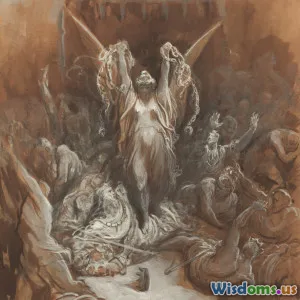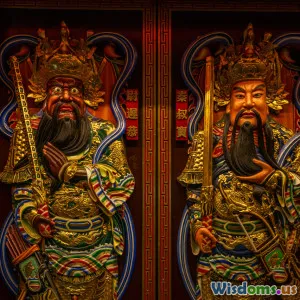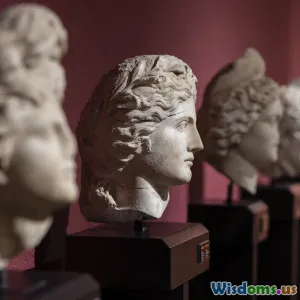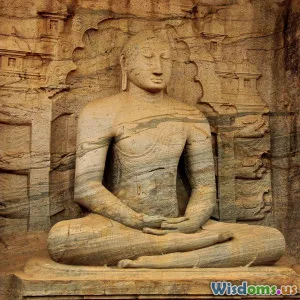
What Norse Myths Reveal About Afterlife Judgment Rituals
14 min read Discover how Norse mythology depicts afterlife judgment, where a soul’s deeds and choices shape their eternal fate—revealing rituals, symbolism, and profound cultural beliefs about life and destiny. (0 Reviews)
What Norse Myths Reveal About Afterlife Judgment Rituals
Introduction: Shadows Beyond the Fjords
In the western imagination, Norse mythology often conjures imagery of thunderous gods, epic battles, and frost-bitten landscapes. Yet, shrouded within the sagas is a lesser-known narrative: Norse perspectives on the afterlife and judgment. Where did a soul go after the last sword was sheathed or the final horn sounded? Unlike many ancient religions, Norse cosmology was not dominated by a singular vision of reward and punishment. Instead, judgment in the Norse afterlife was complex, communal, and—perhaps surprisingly—focused as much on courage, honor, and deeds as the whims of fate. Exploring these myths reveals not just the mindset of the Vikings but invites reflection on how cultures understand life’s ultimate reckoning.
Norse Worldview: Fate and the Fabric of Judgment
Destiny Woven by the Norns
In Norse cosmology, fate was woven by three powerful beings known as the Norns: Urd (the past), Verdandi (the present), and Skuld (the future). Like spinning goddesses, they carved and knotted the destinies of gods and mortals alike. From the moment of birth, a person's life-thread was interlaced with prophecy, personal agency, and the limits set by the Norns.
"Invisible though Fate be, meet it when you may, famed for your courage remain at the day’s end." — Hávamál, The Sayings of the High One
This philosophy meant that afterlife judgment was preordained to a point, but legends abound of beings who tried, sometimes successfully, to shift their destined path through bravery, cunning, or virtue. Thus, the Norse sense of judgment was never entirely punitive or merciful; it was melancholic, heroic, and pragmatic.
The Afterlife: A Plurality of Realms
Unlike the paradisiacal heavens or burning hells of later European religions, the Norse afterlife sprawled across several distinct realms:
- Valhalla: Hall of the slain, reserved for those fallen bravely in battle
- Fólkvangr: Freyja’s field, shared honors with Valhalla
- Hel: Realm of the dead, a cold and bleak domain for those who did not die in combat
- Rán’s Hall: For those claimed by the sea
The fate of a soul depended less on moral "sins" and more on the deeds, manner of death, and—sometimes—luck or grudges held by gods. But how was this fate determined?
The Rituals and Symbols of Norse Afterlife Judgment
Death Rites: Guiding the Soul’s Journey
When a Norse individual died, their community enacted intricate rituals to ease their passage and curry favor with the afterlife’s gatekeepers. Archaeological finds—such as ship burials at Oseberg and Gokstad—testify to these practices:
- Grave Goods: Weapons, jewelry, animals, and even servants were buried with the dead to prepare them for trials beyond the grave.
- Offerings to Gods or Goddesses: Libations and animal sacrifices ensured proper favor from Odin, Freyja, or Hel herself.
By honoring a deceased warrior’s valor, communities believed they tilted the judgment in their favor, nudging them toward Valhalla or Fólkvangr.
The Valkyries: Choosers of the Slain
One of Norse mythology’s most dramatic judgment rituals was the choosing of the slain by supernatural warrior maidens—Valkyries. Depicted as both beautiful and fearsome, Valkyries rode into battlefields, selecting the bravest fallen for Odin’s hall.
In the Poetic Edda, these maidens were seen not just as passive collectors, but as active arbiters of judgment, rewarding the courageous and sometimes punishing the cowardly or unlucky.
"She saw, from the dwellings of fate, those who must die…leaning on bloody spears." — Völuspá, stanza 30
Example: The Saga of Egil Skallagrimsson
In Egil’s Saga, the titular Viking laments the death of his kin, questioning why the Valkyries would pass over worthy warriors or snatch innocents. It hints at mystery—even injustice—surrounding afterlife judgment, affirming the belief that gods and their agents could be as capricious as fate itself.
The Weighing of Deeds: Deeds Over Creeds
Whereas Christian and Egyptian mythologies offer literal images of soul-weighting against a feather or a book of life, the Norse path was more nuanced. Deeds aren’t tallied in a cosmic ledger but become a legend, echoing in poetry, song, and memory.
- Fame (Old Norse: dróttkönguljóð): The Norse believed that immortality was secured through memorable actions. Fame could, in effect, rescue a soul from a dark afterlife.
- Infamy: Adverse, shameful actions (betrayal, cowardice) doomed one to oblivion or dishonor in death—sometimes even as a “draugr,” a restless undead.
Archaeological Insight: Eyrarland Statue
The Eyrarland Statue (Iceland, c. 1000 AD), possibly depicting Thor with Mjölnir, was found among grave goods. Analysts suggest that such amulets invoked protective power—perhaps implying hope for leniency or favor in posthumous judgment.
Journey Through the Afterlife Realms
Valhalla Versus Hel: Merit, Means, or Mischance?
The fate of warriors has fascinated generations. According to Norse myth, only an explicitly heroic death (in combat) won you passage to Valhalla. The rest face an ambiguous eternity:
- Valhalla: A riotous, battle-filled paradise where fallen heroes feast and fight until Ragnarok
- Fólkvangr: An equally honorable destination for chosen heroes, presided over by Freyja
- Hel’s Realm: No overt torture—just a dreary, cold continuation, often seen as humiliation for those not dying heroically
- Rán’s Hall: The drowned met their fate in the embrace of the sea goddess
Real-World Parallel: King Hákon the Good
The 10th-century ruler, Hákon Haraldsson, modeled Christian virtues but maintained pagan practices in death. Snorri Sturluson recounts that, despite Hákon's Christian faith, his loyal followers sent him to Valhalla in their funeral invocations—a fusion of ritual-site judgment blending faiths.
Revenge, Oaths, and the Power of Memory
The Norse afterlife narrative includes many who return from death when wronged, or seek vengeance if rituals are not properly observed. Oaths broken in life could doom a soul after death; conversely, noble kin could secure honor by avenging injustice.
- The Draugr: Restless undead, born of unresolved feuds or insufficient burial rites
- The Nidingr: Cowardly or unworthy individuals so shamed in life that their souls found no rest
Such beliefs enforced strong social bonds during life and served as implicit afterlife "judgment." When saga-writers recorded skips in ritual or betrayed oaths, they matched stories of haunting with lessons about proper conduct.
The Role of Gods: Odin, Hel, and the Divine Arbitrators
Odin: The Allfather’s Paradox
As chief among gods, Odin held ambiguous moral authority. He was a seeker of wisdom, judge of heroes, and yet also a trickster.
- Odin welcomed warriors to Valhalla, judging by bravery not piety
- His fickle favor meant even the greatest heroes could be undone by fate or a broken pact
Hel: Guardian of the Unheroic Dead
Daughter of Loki, Hel presided over the damp, misty land named after her. Rather than devilish punishment, Hel’s realm represented exclusion from glory rather than active torment. Her dominion accrued a sense of cosmic justice—a place for those whose lives and deaths bespoke neither fame nor infamy.
"A gloomy place, only for those whose honor withered before they died." — Gylfaginning, Snorri Sturluson
Case Study: Baldr’s Death
The beloved god Baldr’s soul descended to Hel’s realm after being murdered through Loki’s deception. Negotiations with Hel for Baldr’s release, involving all beings weeping for his return, demonstrate the nuance of Norse afterlife: collective action and memory could alter destinies.
Rituals of Remembrance: Memorials as Posthumous Judgment
Stone Monuments and Dream-Interpretation
Runestones and burial mounds served as enduring reminders of the lives, deeds, and judgments passed on the dead. According to local Norwegian folklore, it was said the carved runes could ensure the deceased was remembered—sometimes even manipulating fate itself.
- Example: The Jelling Stones in Denmark immortalize King Gorm and Queen Thyra, binding their memory and posthumous honor for centuries.
- Dreams of the Dead: Sagas describe dream visits from restless souls, seeking resolution or justice, directly influencing the living to enact or correct judgment.
Blood-Honor and Living Testimonies
With no singular Book of Judgment, the Norse trusted oral tradition—a powerful motivator.
- Bards, skalds, and offspring kept the glory or shame of the dead alive
- The keeping of promises and tales acted as living rituals of ongoing judgment
Comparative Perspective: Norse Afterlife Judgment vs. Others
Individual, Communal, Fated
Norse ritual and myth stand apart from contemporaries in three distinctive ways:
- Judgment as Social Reflection: Destiny reveals itself in how the community remembers the dead, not how a god weighs their heart.
- Heroism Above Dogma: Deeds and their impact outrank rigid theological checklists.
- Negotiable Destinies: From Baldr to commoners, fates could sometimes be swayed by living actions—rites, retellings, revenge.
Insightful Quote
"There is a saying that cattle die, kinsmen die, but one thing never dies: the fame of a dead man." — Hávamál, verse 76
Conclusion: Judgment Beyond Good and Evil
Norse myths confront us with a vision of judgment that is neither strictly punitive nor heavenly. Afterlife rituals entwined memory, community, and personal honor—interpreted by mortal and immortal alike. Sagas of gods choosing, kin honoring or forgetting, and even the return of wraiths hammer home a key insight: for the Norse, the measure of judgment was how one faced life—and how one was remembered.
Modern readers can draw inspiration from this worldview: true immortality lies not merely in accolades or wealth, but in honorable deeds, fairness, and the honoring of oaths. Instead of a rigid afterlife courtroom, the Norse offer a fluid ritual of memory and fate—open to every act of courage or folly, and every retelling that shapes the legacy of a life. In the end, Norse afterlife judgment rituals teach us that it is not where, but how we live and are remembered that determines our place beyond the mists.
Further Reading:
- Ellis Davidson, H. R. Gods and Myths of Northern Europe
- Neil Price, Children of Ash and Elm: A History of the Vikings
- Snorri Sturluson, The Prose Edda
Rate the Post
User Reviews
Other posts in Underworld & Afterlife Myths
Popular Posts















